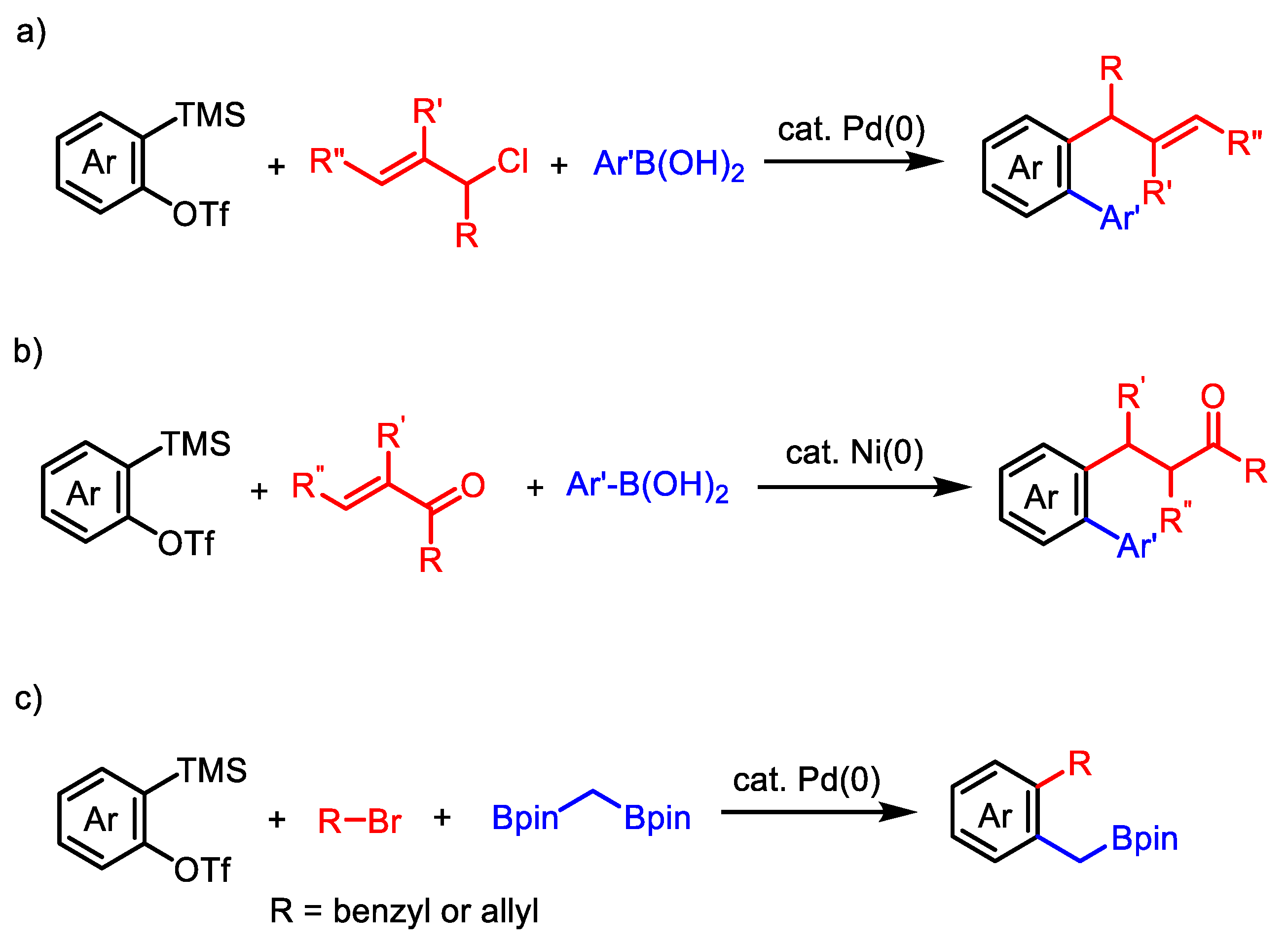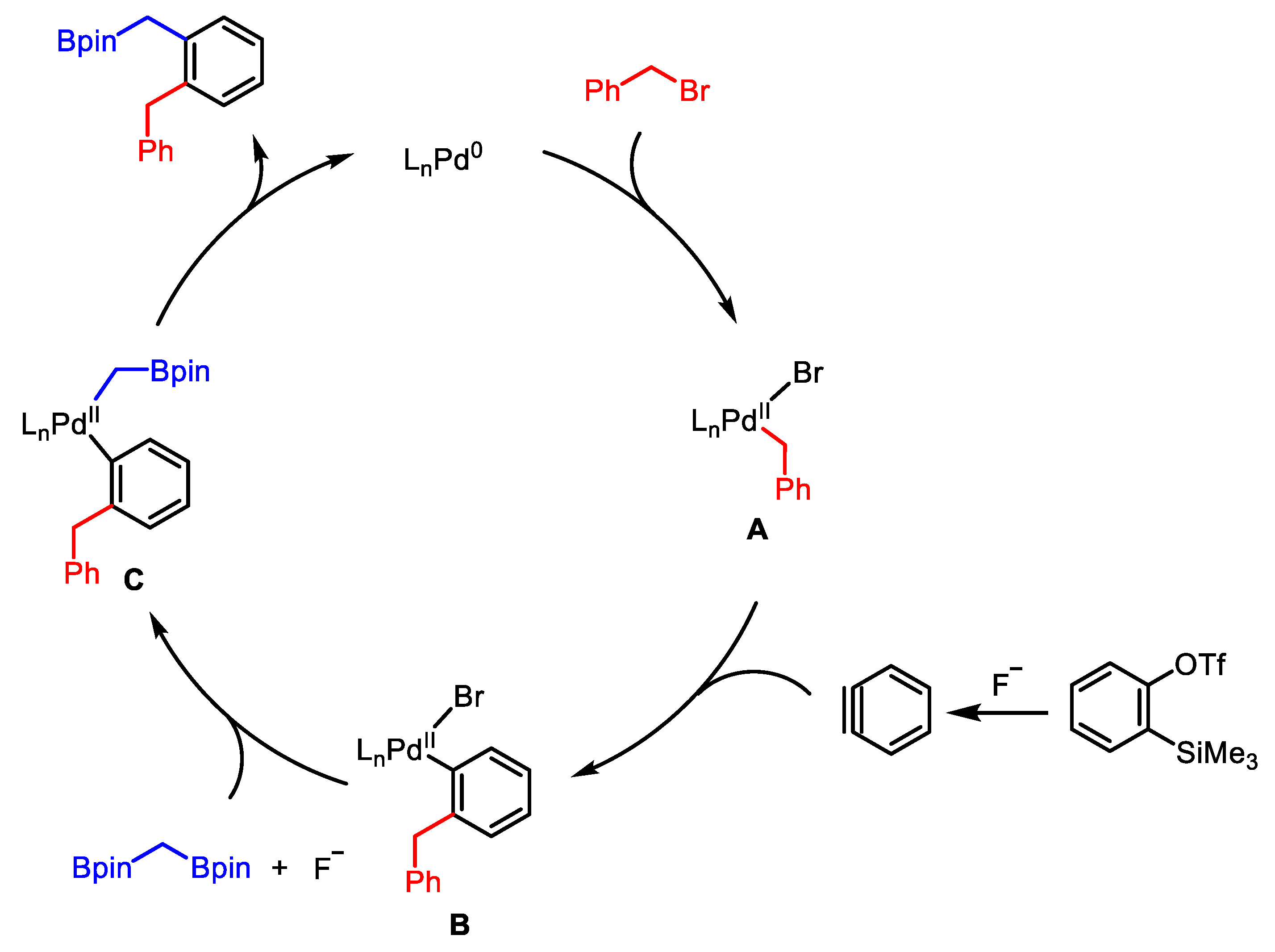Palladium-Catalyzed Three-Component Coupling of Benzynes, Benzylic/Allylic Bromides and 1,1-Bis[(pinacolato)boryl]methane
Abstract
:1. Introduction
2. Results
3. Materials and Methods
3.1. Materials
3.2. Methods
4. Conclusions
Supplementary Materials
Author Contributions
Funding
Data Availability Statement
Acknowledgments
Conflicts of Interest
References
- Zhu, J.; Wang, Q.; Wang, M. Multicomponent Reactions in Organic Synthesis; Wiley VCH: Weinheim, Germany, 2015. [Google Scholar]
- Lesma, G.; Cecchi, R.; Crippa, S.; Giovanelli, P.; Meneghetti, F.; Musolino, M.; Sacchetti, A.; Silvani, A. Ugi 4-CR/Pictet–Spengler reaction as a short route to tryptophan-derived peptidomimetics. Org. Biomol. Chem. 2012, 10, 9004–9012. [Google Scholar] [CrossRef] [PubMed]
- Van der Heijden, G.; Ruijter, E.; Orru, R.V.A. Efficiency, diversity, and complexity with multicomponent reactions. Synlett 2013, 24, 666–685. [Google Scholar]
- Guo, X.; Hu, W. Novel multicomponent reactions via trapping of protic onium ylides with electrophiles. Acc. Chem. Res. 2013, 46, 2427–2440. [Google Scholar] [CrossRef] [PubMed]
- Eberlin, L.; Tripoteau, F.; Carreaux, F.; Whiting, A.; Carboni, B. Boron-substituted 1,3-dienes and heterodienes as key elements in multicomponent processes. Beilstein J. Org. Chem. 2014, 10, 237–250. [Google Scholar] [CrossRef]
- Koopmanschap, G.; Ruijter, E.; Orru, R.V.A. Isocyanide-based multicomponent reactions towards cyclic constrained peptidomimetics. Beilstein J. Org. Chem. 2014, 10, 544–598. [Google Scholar] [CrossRef]
- Rotstein, B.H.; Zaretsky, S.; Rai, V.; Yudin, A.K. Small heterocycles in multicomponent reactions. Chem. Rev. 2014, 114, 8323–8359. [Google Scholar] [CrossRef]
- Brauch, S.; van Berkel, S.S.; Westermann, B. Higher-order multicomponent reactions: Beyond four reactants. Chem. Soc. Rev. 2013, 42, 4948–4962. [Google Scholar] [CrossRef]
- Neochoritis, C.G.; Zhao, T.; Domling, A. Tetrazoles via multicomponent reactions. Chem. Rev. 2019, 119, 1970–2042. [Google Scholar] [CrossRef] [Green Version]
- Dömling, A. Recent advances in isocyanide-based multicomponent chemistry. Curr. Opin. Chem. Biol. 2002, 6, 306–313. [Google Scholar] [CrossRef]
- Domling, A.; Wang, W.; Wang, K. Chemistry and biology of multicomponent reactions. Chem. Rev. 2012, 112, 3083–3135. [Google Scholar] [CrossRef] [Green Version]
- Estevez, V.; Villacampa, M.; Menéndez, J.C. Multicomponent reactions for the synthesis of pyrroles. Chem. Soc. Rev. 2010, 39, 4402–4421. [Google Scholar] [CrossRef]
- Estevez, V.; Villacampa, M.; Menéndez, J.C. Recent advances in the synthesis of pyrroles by multicomponent reactions. Chem. Soc. Rev. 2014, 43, 4633–4657. [Google Scholar] [CrossRef] [PubMed]
- Blasco, E.; Sims, M.B.; Goldmann, A.S.; Sumerlin, B.S.; Barner-Kowollik, C. 50th Anniversary Perspective: Polymer Functionalization. Macromolecules 2017, 50, 5215–5252. [Google Scholar] [CrossRef]
- Kakuchi, R. Multicomponent reactions in polymer synthesis. Angew. Chem. Int. Ed. 2014, 53, 46–48. [Google Scholar] [CrossRef] [PubMed]
- Theato, P. Multi-Component and Sequential Reactions in Polymer Synthesis; Springer International Publishing: Berlin/Heidelberg, Germany, 2015; Volume 269. [Google Scholar]
- Shi, J.; Li, L.; Li, Y. o-Silylaryl triflates: A journey of Kobayashi aryne precursors. Chem. Rev. 2021, 121, 3892–4044. [Google Scholar] [CrossRef] [PubMed]
- Sarmah, M.; Hazarika, H.; Gogoi, P. Aryne annulations for the synthesis of carbocycles and hetero-cycles: An updated review. Synthesis 2022, 54, 4932–4962. [Google Scholar]
- Dubrovskiy, A.V.; Markina, N.A.; Larock, R.C. Use of benzynes for the synthesis of heterocycles. Org. Biomol. Chem. 2013, 11, 191–218. [Google Scholar] [CrossRef]
- Jayanth, T.T.; Jeganmohan, M.; Cheng, C.-H. Highly efficient route to o-allylbiaryls via palladium-catalyzed three-component coupling of benzynes, allylic halides, and aryl organometallic reagents. Org. Lett. 2005, 7, 2921–2924. [Google Scholar] [CrossRef]
- Jayanth, T.T.; Cheng, C.-H. Nickel-catalyzed coupling of arynes, alkenes, and boronic acids: Dual role of the boronic acid. Angew. Chem. Int. Ed. 2007, 46, 5921–5924. [Google Scholar] [CrossRef]
- Jeganmohan, M.; Cheng, C.-H. Palladium-catalyzed allylalkynylation of benzynes: A highly efficient route to substituted 1-allyl-2-alkynylbenzenes. Org. Lett. 2004, 6, 2821–2824. [Google Scholar] [CrossRef]
- Bhuvaneswari, S.; Jeganmohan, M.; Cheng, C.-H. Carbocyclization of aromatic iodides, bicyclic alkenes, and benzynes involving a palladium-catalyzed C−H bond activation as a key step. Org. Lett. 2006, 8, 5581–5584. [Google Scholar] [CrossRef]
- Bhuvaneswari, S.; Jeganmohan, M.; Yang, M.-C.; Cheng, C.-H. Palladium-catalyzed three-component coupling of arynes with allylic acetates or halides and terminal alkynes promoted by cuprous iodide. Chem. Commun. 2008, 2158–2160. [Google Scholar] [CrossRef]
- Jeganmohan, M.; Bhuvaneswari, S.; Cheng, C.-H. A cooperative copper- and palladium-catalyzed three-component coupling of benzynes, allylic epoxides, and terminal alkynes. Angew. Chem. Int. Ed. 2009, 48, 391–394. [Google Scholar] [CrossRef] [PubMed]
- Dong, Y.; Li, Y.; Wei, Y.-L.; Wang, J.-C.; Ma, J.-P.; Ji, J.; Yao, B.-J.; Dong, Y.-B. A N-heterocyclic tetracarbene Pd(II) moiety containing a Pd(II)–Pb(II) bimetallic MOF for three-component cyclotrimerization via benzyne. Chem. Commun. 2016, 52, 10505–10508. [Google Scholar] [CrossRef] [PubMed]
- Paul, S.; Das, K.K.; Aich, D.; Manna, S.; Panda, S. Recent developments in the asymmetric synthesis and functionalization of symmetrical and unsymmetrical gem-diborylalkanes. Org. Chem. Front. 2022, 9, 838–852. [Google Scholar] [CrossRef]
- Lee, Y.; Han, S.; Cho, S.H. Catalytic chemo- and enantioselective transformations of gem-diborylalkanes and (diborylmethyl)metallic species. Acc. Chem. Res. 2021, 54, 3917–3929. [Google Scholar] [CrossRef]
- Nallagonda, R.; Padala, K.; Masarwa, A. gem-Diborylalkanes: Recent advances in their preparation, transformation and application. Org. Biomol. Chem. 2018, 16, 1050–1064. [Google Scholar] [CrossRef]
- Miralles, N.; Maza, R.J.; Fernández, E. Synthesis and reactivity of 1,1-diborylalkanes towards C–C bond formation and related mechanisms. Adv. Synth. Catal. 2018, 360, 1306–1327. [Google Scholar] [CrossRef]
- Wu, C.; Wang, J. Geminal bis(boron) compounds: Their preparation and synthetic applications. Tetrahedron Lett. 2018, 59, 2128–2140. [Google Scholar] [CrossRef]
- Jo, W.; Lee, J.H.; Cho, S.H. Advances in transition metal-free deborylative transformations of gem-diborylalkanes. Chem. Commun. 2021, 57, 4346–4353. [Google Scholar] [CrossRef]
- Xu, L.; Zhang, S.; Li, P. Boron-selective reactions as powerful tools for modular synthesis of diverse complex molecules. Chem. Soc. Rev. 2015, 44, 8848–8858. [Google Scholar] [CrossRef] [PubMed]
- Endo, K.; Ohkubo, T.; Hirokami, M.; Shibata, T. Chemoselective and regiospecific Suzuki coupling on a multisubstituted sp3-carbon in 1,1-diborylalkanes at room temperature. J. Am. Chem. Soc. 2010, 132, 11033–11035. [Google Scholar] [CrossRef]
- Endo, K.; Ohkubo, T.; Shibata, T. Chemoselective Suzuki coupling of diborylmethane for facile synthesis of benzylboronates. Org. Lett. 2011, 13, 3368–3371. [Google Scholar] [CrossRef] [PubMed]
- Endo, K.; Ishioka, T.; Ohkubo, T.; Shibata, T. One-pot synthesis of symmetrical and unsymmetrical diarylmethanes via diborylmethane. J. Org. Chem. 2012, 77, 7223–7231. [Google Scholar] [CrossRef] [PubMed]
- Endo, K.; Ohkubo, T.; Ishioka, T.; Shibata, T. Cross coupling between sp3-carbon and sp3-carbon using a diborylmethane derivative at room temperature. J. Org. Chem. 2012, 77, 4826–4831. [Google Scholar] [CrossRef]
- Li, H.; Shangguan, X.; Zhang, Z.; Huang, S.; Zhang, Y.; Wang, J. Formal carbon insertion of N-tosylhydrazone into B–B and B–Si bonds: Gem-diborylation and gem-silylborylation of sp3 carbon. Org. Lett. 2014, 16, 448–451. [Google Scholar] [CrossRef]
- Li, H.; Zhang, Z.; Shangguan, X.; Huang, S.; Chen, J.; Zhang, Y.; Wang, J. Palladium(0)-catalyzed cross-coupling of 1,1-diboronates with vinyl bromides and 1,1-dibromoalkenes. Angew. Chem. Int. Ed. 2014, 53, 11192–11925. [Google Scholar] [CrossRef]
- Xu, S.; Shangguan, X.; Li, H.; Zhang, Y.; Wang, J. Pd(0)-Catalyzed cross-coupling of 1,1-diboronates with 2,2′-dibromobiphenyls: Synthesis of 9H-fluorenes. J. Org. Chem. 2015, 80, 7779–7784. [Google Scholar] [CrossRef]
- Wu, C.; Wu, G.; Zhang, Y.; Wang, J. One-carbon homologation of arylboronic acids: A convenient approach to the synthesis of pinacol benzylboronates. Org. Chem. Front. 2016, 3, 817–822. [Google Scholar] [CrossRef]
- Stymiest, J.; Bagutski, V.; French, R.; Aggarwal, V. Enantiodivergent conversion of chiral secondary alcohols into tertiary alcohols. Nature 2008, 456, 778–782. [Google Scholar] [CrossRef]
- Li, Z.; Song, L.; Li, C. Silver-catalyzed radical aminofluorination of unactivated alkenes in aqueous media. J. Am. Chem. Soc. 2013, 135, 4640–4643. [Google Scholar] [CrossRef] [PubMed]
- Crudden, C.; Ziebenhaus, C.; Rygus, J.; Ghozati, K.; Unsworth, P.; Nambo, M.; Voth, S.; Hutchinson, M.; Laberge, V.; Maekawa, Y.; et al. Iterative protecting group-free cross-coupling leading to chiral multiply arylated structures. Nat. Commun. 2016, 7, 11065–11072. [Google Scholar] [CrossRef] [PubMed] [Green Version]
- Hong, K.; Liu, X.; Morken, J. Simple access to elusive α-boryl carbanions and their alkylation: An umpolung construction for organic synthesis. J. Am. Chem. Soc. 2014, 136, 10581–10584. [Google Scholar] [CrossRef] [PubMed]




 | ||||
|---|---|---|---|---|
| Entry | [Pd] | [P] | Base | Yield (%) [b] |
| 1 | PdCl2 | dppe | CsF | 47 |
| 2 | Pd(MeCN)2Cl2 | dppe | CsF | 56 |
| 3 | Pd2(dba)3 | dppe | CsF | 39 |
| 4 | Pd(OAc)2 | dppe | CsF | 61 |
| 5 | Pd(OAc)2 | dppe | CsF | 53 |
| 6 | Pd(OAc)2 | PPh3 | CsF | 65 |
| 7 | Pd(OAc)2 | (p-MeOC6H4)3P | CsF | 61 |
| 8 | Pd(OAc)2 | (p-CF3C6H4)3P | CsF | 64 |
| 9 | Pd(OAc)2 | (p-FC6H4)3P | CsF | 69 |
| 10 [c] | Pd(OAc)2 | (p-FC6H4)3P | CsF | 77 [d] |
| 11 [e] | Pd(OAc)2 | (p-FC6H4)3P | CsF | 43 |
| 12 | Pd(OAc)2 | (p-FC6H4)3P | KF | 0 |
| 13 | Pd(OAc)2 | (p-FC6H4)3P | KF/18-Crown-6 | 6 |
Disclaimer/Publisher’s Note: The statements, opinions and data contained in all publications are solely those of the individual author(s) and contributor(s) and not of MDPI and/or the editor(s). MDPI and/or the editor(s) disclaim responsibility for any injury to people or property resulting from any ideas, methods, instructions or products referred to in the content. |
© 2023 by the authors. Licensee MDPI, Basel, Switzerland. This article is an open access article distributed under the terms and conditions of the Creative Commons Attribution (CC BY) license (https://creativecommons.org/licenses/by/4.0/).
Share and Cite
Bao, Z.; Wu, C.; Wang, J. Palladium-Catalyzed Three-Component Coupling of Benzynes, Benzylic/Allylic Bromides and 1,1-Bis[(pinacolato)boryl]methane. Catalysts 2023, 13, 126. https://doi.org/10.3390/catal13010126
Bao Z, Wu C, Wang J. Palladium-Catalyzed Three-Component Coupling of Benzynes, Benzylic/Allylic Bromides and 1,1-Bis[(pinacolato)boryl]methane. Catalysts. 2023; 13(1):126. https://doi.org/10.3390/catal13010126
Chicago/Turabian StyleBao, Zhicheng, Chaoqiang Wu, and Jianbo Wang. 2023. "Palladium-Catalyzed Three-Component Coupling of Benzynes, Benzylic/Allylic Bromides and 1,1-Bis[(pinacolato)boryl]methane" Catalysts 13, no. 1: 126. https://doi.org/10.3390/catal13010126







